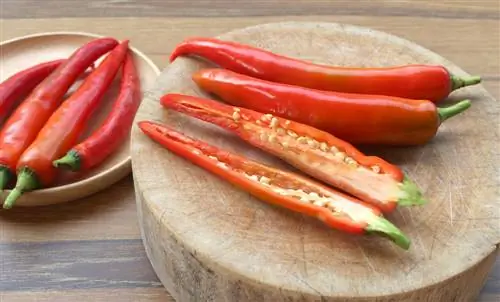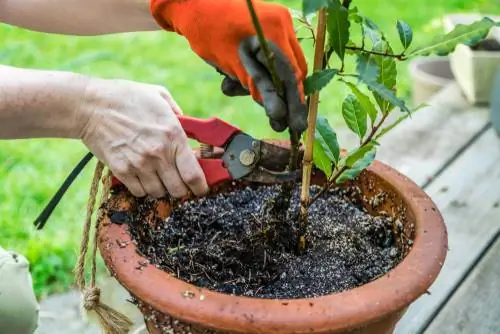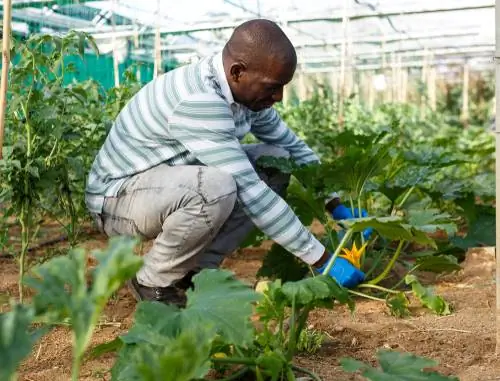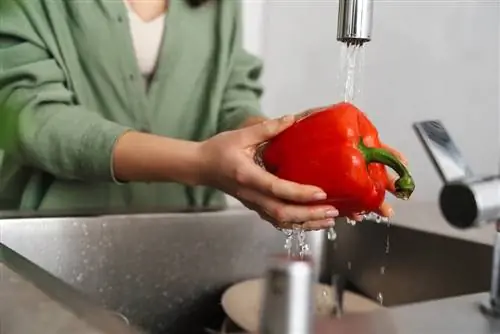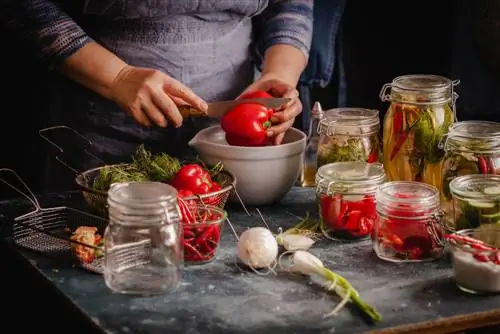- Author admin [email protected].
- Public 2023-12-16 16:46.
- Last modified 2025-06-01 06:02.
You can let your pepper plants grow uncut and enjoy the fiery, aromatic yield. With pruning care on a budget, you can significantly optimize the harvest quality. Read this tutorial on how to cut peppers expertly.
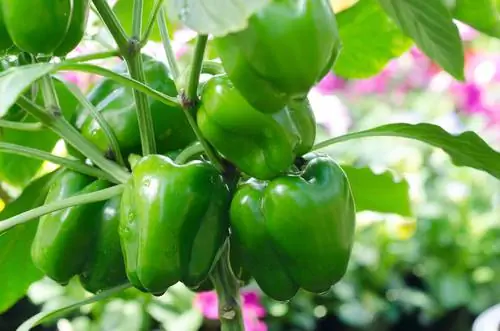
How do I cut peppers correctly?
To cut peppers correctly, remove sterile shoots and the royal flower. Harvest ripe peppers with scissors and cut them ready to eat by cutting off the top and bottom and peeling out the inside.
Use the peppers
When cutting tomato plants, pinching is a must in gardening. Paprika is more tolerant of the measure and leaves the decision up to you. Infertile side shoots, the so-called stingy shoots, are removed with the aim of increasing the flower yield and correspondingly higher number of fruits. The unwanted shoots can be recognized by their position within a leaf axil, the fork of the main shoot and fruit shoot. This is how you properly maximize pepper plants:
- The best time is in the morning in dry weather
- Use your index finger and thumb to grasp a stinging shoot at the lower end
- Pinch off the mini shoot or break it off to the side
- Important: the smaller the miserliness, the gentler the procedure
Have you prescribed regular rooting for your pepper plants? Then the work is on the care plan from the young plant stage onwards. Stay on the heels of stingy shoots until the first fruits form. Experience in growing peppers shows that without thinning, a densely bushy plant develops with a large leaf mass and few fruits. Where barren side shoots do not divert nutrients for themselves, there are even more reserve substances available for the growth of juicy peppers.
Tip
Continuous austerity is a double-edged sword. Primarily the harvest quality improves. In return, the intervention affects the stability of a pepper plant. Without stingy shoots, the plants grow slimmer and less bushy, so they are at risk from windthrow. You can prevent damage by placing a support rod next to the main shoot.
Break out royal blossom
Pepper gardeners who want to produce a high-yielding plant find the royal flower a thorn in their side. The poetic term refers to the flower of the first hour, which is located in the center of the first branching of the stem. The plant pumps a large part of its energy reserves towards its royal flower, so that further buds are left behind. Profitability benefits significantly when no royal blossom wields the floral scepter. How to do it professionally:
- Remove the top flower of a pepper plant promptly
- Hold the flower base with two fingers
- You can choose to twist out, pinch out or break out the royal blossom
So that your pepper plant does not lack strength for the following growth spurt, apply an organic fertilizer every two weeks. Compost, horn shavings and plant manure are well suited. After the end of the flowering period, shorten the fertilization intervals to eight days so that the numerous fruit sets develop into voluminous and aromatic peppers.
Harvest the first peppers half ripe
Did you miss the time to break out the royal blossom? Then you have a second opportunity to optimize the branching with fruit shoots and number of flowers. To do this, harvest the first fruit early when it is still green and half ripe. The pepper plant interprets the intervention as a loss of its ovules and immediately sets to work producing more flowers and fruits for many-headed offspring.
Background
Remove the tip bud - allocate growth power more evenly
The reaction of a pepper plant to the removal of the royal flower can be reliably predicted because an important growth law is applied. The insight into tip promotion, known in technical jargon as apical dominance, is thanks to precise observations of plant growth. Buds at the tips of the shoots receive disproportionately more nutrients than buds positioned deeper. By breaking out the royal flower of a pepper plant, you cause a more even allocation of reserve substances. As a result, more fruit tendrils sprout with flowers that turn into crunchy fruits.
Do not pick ripe peppers
Scissors are only used in the final stages of growing peppers. Removing pinnips and royal flowers requires dexterity. Ripe fruits dangle from sturdy stems that resist any attempt to pick them. For a skilful harvest, the scissors should be ready to hand. Ideally, place the blades in the middle of the fruit stem. Injury to the plant is ruled out. Furthermore, peppers last longer if a small piece of the stem remains on the fruit.
Cut before putting away
The approaching winter is another reason to prune pepper plants. As tropical plants, peppers cannot tolerate frosty temperatures, so they are usually grown as annuals in our regions. In their habitats, the plants thrive as perennials, which hobby gardeners take advantage of and organize overwintering behind glass. As part of the preparations, vigorous cutting plays a key role. How to properly prune pepper plants before putting them away:
- The best time is in autumn when temperatures are around 10 degrees Celsius
- Thoroughly clean and disinfect scissors with bypass mechanism
- Cut back all shoots by half to two thirds
- Leave at least two pairs of leaves per shoot
After pruning, dig up a bedding plant to plant in a pot with vegetable soil. If you have to make do with limited space in your winter quarters, you can reduce the size of an oversized root ball by up to a third. If your peppers thrive in the pot anyway, the preparations are limited to a radical cut before putting them away.
Excursus
Never cut without gloves
Capsaicin is contained in varying degrees in peppers. This is an alkaloid that gives it the spicy taste. The amount of capsaicin in sweet peppers is hardly worth mentioning, whereas caution is advised in other varieties such as chili or hot peppers. This doesn't just apply to the palate. Direct skin contact can trigger allergic reactions and even burns. In the worst case, the alkaloid gets into the eyes and mucous membranes, causing considerable discomfort. Do not approach your peppers until you are wearing protective gloves and long-sleeved clothing.
Cut peppers ready to eat
With its colorful peel and tasty pulp, the pepper protects its true treasure, the seeds. From a kitchen perspective, the seeds could easily be deleted from the fruit's floral blueprint. To cut a pod ready for consumption, it is usually first quartered and then cut into strips or small cubes. The clean-up work at the workplace then begins because the annoying seeds have spread over a large area. That doesn't have to be the case. How to cut a pepper correctly:
- Put peppers on a cutting board
- Cut off the top and bottom with a sharp kitchen knife
- Set the pod upright
- Cut the peel with pulp from top to bottom
Starting from the vertical cut, use the knife blade to peel out the seed-rich interior of the pod. The special advantage of this method: the seeds in their chambers remain connected to the light tissue and are removed in one go.

Frequently asked questions
Are pepper plant shoots suitable for propagation?
Sowing dominates as the common form of propagation of pepper plants in commercial and private cultivation. There is no reason why you should try the vegetative route with cuttings. Instead of carelessly throwing escaped shoots onto the compost heap, they go into a pot with potting soil. Place a plastic bag over it with wooden sticks as spacers and keep the substrate slightly moist at all times.
Are peppers hardy?
Peppers are native to tropical regions of the world. Where there are pleasant temperatures all year round, the plants thrive as perennials. Pepper plants are not designed for temperatures below freezing, so overwintering in the Central European garden is not possible. If the thermometer falls and 10 degrees Celsius, peppers stop growing and gradually die. As long as you are not afraid of the effort and have a bright, frost-free winter quarters, you can accompany the exotic plants through the cold season behind glass.
Is it possible to grow peppers on the balcony?
As a balcony gardener, you don't have to go without fresh, home-grown peppers. The plants thrive in large pots as long as they are given a sunny, warm and wind-protected location. As heavy feeders, pepper plants need nutrient-rich soil, ideally enriched with compost. The necessary support is provided by a spiral rod to which the main shoot and fruit shoots can nestle. The linchpin of the care program is an adequate supply of water and nutrients. Especially on hot summer days, the plants evaporate a lot of moisture, so regular watering is important.
Are pepper plants self-fertile or should there be a second plant in the bed?
Most pepper varieties for private cultivation are self-fertile, thanks to hermaphrodite flowers with female and male reproductive organs. A single plant is enough for a rich harvest. In a very windless location or in a greenhouse, it is advisable to shake the plant every now and then so that the pollen is distributed evenly.
The 3 most common cutting mistakes
If stingy shoots gain the upper hand in a pepper plant, fruit quality and yield fall by the wayside. A plant experiences a similar situation when the royal flower is in charge. Extensive clean-up work in the kitchen is inevitable if you simply quarter a fruit. The following table would like to protect you from typical cutting errors and has tips for the correct procedure:
| Cutting errors | malicious image | Prevention |
|---|---|---|
| never exhausted | high leaf mass, low crop yield | Continuously break out miserliness |
| Let the royal blossom be granted | few fruit shoots, flowers and peppers | Remove Royal Flower |
| Pepper quartered | large-scale distribution of seeds | Cut off the lid and base, peel out the seeds |
Tip
Chili plants benefit from consistent cultivation, like their milder relatives peppers and tomatoes. It starts at a height of 35 to 40 cm. Break out from the leaf axils all the protruding shoots that compete with the fruit shoots for nutrients, water and light.


